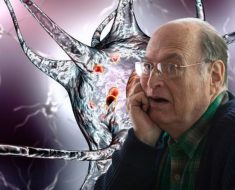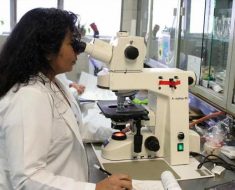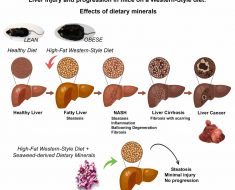Sara Geurts, from Minnesota, has Ehlers Danlos Syndrome (EDS), a connective tissue disorder that means her body lacks collagen.
While most people with EDS show no visible signs, Sara’s rarer form of Dermatosparaxis EDS causes her skin to sag excessively.
The condition has left her bed-bound and unable to eat, and she’s now trying to raise money to help her travel to get the right treatment.
In hopes of raising awareness of her condition, Sara spoke out about it on Instagram, and has since gained over 76,000 followers as a body image influencer.
But she said she’s still suffering with extremely poor health, and that the last year has been one of the hardest ever.
‘These last four years of my life I feel like have been the best years that I’ve ever lived just because they’ve been lived to what I feel is my genuine and my authentic self,’ Sara said.
‘And how I feel about my body is how I want everyone to feel about their body no matter their circumstances or what they are in.
‘From being admitted to different books, to magazines, with Winnie Harlow, Wiz Khalifa, Mandy Moore, different, inspirational figures like that.
‘It’s been quite the exciting journey ever since then for sure.’
Sara first started posing for pictures on her Instagram account, with photographer girlfriend Bri Berglund behind the camera.

She said: ‘Bri was the one who was the main inspiration in terms and support of what I was doing in terms of loving my body and loving myself.
‘I was at a really bad point in my life, really bad habits, really bad people and it took a lot of cleansing in terms of that and she was there to help see that light and to aid me through that journey.
‘We chose to use my symptoms of my disorder through photography as a way to help others or try to, because [EDS] is known as the invisible illness, I’m kind of the rare case where I am visible.
‘And so that’s why a lot of people out there aren’t getting the treatment that they need because the doctors can’t physically see anything wrong with them.
‘And why I chose to say “okay, fine if I have something that I can show about my disorder why not use that?”‘
Common symptoms of EDS include joint hypermobility and pain, fatigue, loose skin and digestive problems.
But the condition can affect every sufferer differently.
Sara explains: ‘It’s a collagen deficiency. So collagen is found in your skin, in your ligaments.
‘For me, I don’t have any collagen in my skin, which causes that extreme laxity.’
It wasn’t until she was six or seven that she started to really become aware of her stretchy skin.
‘All the kids in the neighbourhood thought I was so cool, because I had the stretchy skin,’ Sara said.
‘And then I think it wasn’t until in-between the ages of eight and 10 that I was diagnosed.’

Over the last few years, Sara has learned to embrace her body. But, as a teenager, she was incredibly self-conscious and would hide her body away.
She said: ‘I just wanted to cover it up. I didn’t want anyone asking me about it. I wore jeans and sweaters at 90-degree weather.
‘I refused go to the pool; didn’t want to be in a swimsuit all that type of stuff, just because I knew people would look and people would wonder.’
It wasn’t until she hit her twenties that Sara finally found the confidence to not only show off her body but to wholeheartedly love it.
Sara said: ‘I think back to the times in high school or just even in the past when I didn’t love myself and just how toxic everything was in the lifestyle that I was leading.
‘And it saddens [me] that I tried to cover it up and that I was so insecure.
‘Now it’s just a complete 360, it’s like I am who I am, my disorder is a part of me but I’m not my disorder. And I love my body.’
Sara is now raising money through GoFundMe for treatment.
Because of this, she has been able to see an EDS specialist in Minneapolis; however this won’t cover the ongoing medical costs.
‘We did find the high possibility of gastroparesis and then we did also find the possibility of mass cell activation disease or another underlying disease or disorder,’ said Sara.
‘So we have quite a long way to go in terms of the tests and the specialist that we have to see.’
Source: Read Full Article





